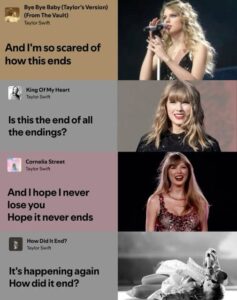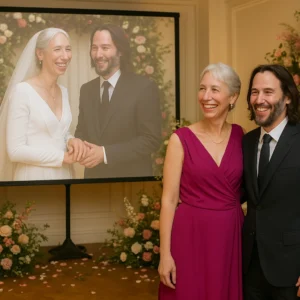Taylor Swift’s songwriting is a masterclass in storytelling, with lyrics that weave emotional threads across her discography. Among her most compelling techniques is the use of lyric parallels—recurring motifs that evolve to reflect her growth. The theme of endings, whether the close of a relationship, the fading of a dream, or the start of a new chapter, is central to her work. Four songs—”Bye Bye Baby (Taylor’s Version),” “King of My Heart,” “Cornelia Street,” and “How Did It End?”—exemplify this, each offering a unique perspective on closure. From the raw grief of a final farewell to the hope of a lasting love, these tracks create a poignant narrative arc. This article explores the lyric parallels about endings in these songs, connecting them to Swift’s broader catalog and her enduring ability to capture life’s transitions.
The Spectrum of Endings
Swift’s discography is a mosaic of emotional eras, and endings are a recurring motif that she revisits with nuance. “Bye Bye Baby (Taylor’s Version),” a vault track from Fearless (Taylor’s Version) (2021), mourns a love lost to unfulfilled promises. “King of My Heart” from Reputation (2017) celebrates the end of romantic turmoil with a new beginning. “Cornelia Street” from Lover (2019) dreads the potential end of a cherished relationship, while “How Did It End?” from The Tortured Poets Department (2024) dissects the aftermath of a breakup under public scrutiny. Together, these songs span Swift’s career, showcasing her evolving perspective on closure. Fan analyses on platforms like Reddit and Tumblr highlight how these tracks resonate, with listeners uncovering parallels that deepen their appreciation of her artistry.
“Bye Bye Baby”: The Pain of a Final Farewell
“Bye Bye Baby,” originally an outtake from Fearless (2008), is a country-pop ballad about driving away from a failed relationship. The chorus—“Bye, bye to everything I thought was on my side / Bye, bye, baby / I want you bad, but it’s come down to nothing”—captures the devastation of losing not just a partner, but the dreams tied to them. The line “I’m so scared of how this ends” echoes “The Story of Us” from Speak Now (2010), where Swift sings, “Oh, I’m scared to see the ending.” Both songs express fear of a relationship’s collapse, using “end” to underscore finality. The bridge’s imagery—“All the pages are just slipping through my hands”—parallels “Enchanted” from the same album: “This was the very first page, not where the story line ends.” In both, endings feel like unfinished stories, reflecting Swift’s early struggles with closure.

“King of My Heart”: Endings as New Beginnings
In contrast, “King of My Heart” from Reputation reimagines endings as opportunities for renewal. The bridge’s pivotal line—“Is this the end of all the endings? / My broken bones are mending”—suggests a relationship that halts Swift’s cycle of heartbreaks, likely inspired by Joe Alwyn. This parallels “Lover” from Lover, where she sings, “All’s well that ends well to end up with you,” framing closure as a joyful resolution. The metaphor of “broken bones mending” connects to “Clean” from 1989 (2014): “When I was drowning, that’s when I could finally breathe.” Both songs depict the end of pain as a cathartic release, but “King of My Heart” attributes healing to a new love, showcasing Swift’s shift to optimism. Fans on X note that this hopeful take on endings resonates with those who’ve found love after loss.

“Cornelia Street”: The Fear of Irreversible Loss
“Cornelia Street” from Lover takes a different approach, exploring the terror of a potential ending. The song, tied to Swift’s New York apartment and her romance with Alwyn, is both nostalgic and anxious. The chorus—“I’d never walk Cornelia Street again / That’s the kinda heartbreak time could never mend”—portrays an ending so devastating it would erase sacred memories. This fear of permanent loss parallels “All Too Well” from Red (2012), where Swift sings, “They say all’s well that ends well, but I’m in a new hell.” Both songs grapple with endings that linger, but “Cornelia Street” is prospective, dreading a future loss rather than mourning a past one. The line “I hope I never lose you” echoes “Call It What You Want” from Reputation: “I want to wear his initial on a chain round my neck.” Both express a desperate wish to preserve love, highlighting Swift’s vulnerability.

“How Did It End?”: The Aftermath of Closure
“How Did It End?” from The Tortured Poets Department offers a reflective take on endings, focusing on a breakup’s emotional and social fallout. The opening line—“We hereby conduct this post-mortem”—sets a clinical tone, as Swift examines a relationship’s demise, possibly with Matty Healy or Joe Alwyn. The repeated question “How did it end?” mirrors “The Story of Us”: “How’d we end up this way?” Both songs probe the mechanics of a breakup, seeking answers to its unraveling. The line “Say it once again with feeling / How the death rattle breathing / Silenced as the soul was leaving” uses vivid imagery to depict a relationship’s final moments, paralleling “My Tears Ricochet” from folklore (2020): “And I can go anywhere I want, just not home.” Both evoke a haunting sense of loss, with endings leaving emotional scars. Fan discussions on Tumblr suggest “How Did It End?” resonates for its raw honesty about public curiosity and private pain.

Interconnected Themes and Parallels
These four songs, spanning over a decade, create a dialogue about endings in Swift’s work. The fear of closure in “Bye Bye Baby” and “Cornelia Street” contrasts with the hope of “King of My Heart,” while “How Did It End?” offers a retrospective lens. Imagery of journeys—driving in “Bye Bye Baby,” walking away in “Cornelia Street”—ties to “Getaway Car” from Reputation, where escape marks an ending. The motif of unfinished stories in “Bye Bye Baby” and “How Did It End?” echoes “Cardigan” from folklore: “Tried to change the ending.” Meanwhile, the healing in “King of My Heart” and “Cornelia Street”’s plea for permanence connect to “Daylight” from Lover: “I once believed love would be burning red / But it’s golden.” These parallels show Swift’s ability to revisit endings with fresh perspectives, creating a cohesive narrative.

The Emotional Resonance
Swift’s fans, known as Swifties, play a key role in decoding these parallels, sharing theories on platforms like Reddit about which songs reference which relationships. “Bye Bye Baby” is often linked to Joe Jonas, “King of My Heart” and “Cornelia Street” to Alwyn, and “How Did It End?” to Healy or Alwyn’s breakup. While Swift rarely confirms these speculations, her lyrics invite personal interpretation, making her endings universally relatable. The raw vulnerability of “Bye Bye Baby,” the triumph of “King of My Heart,” the anxiety of “Cornelia Street,” and the introspection of “How Did It End?” offer something for every listener, whether they’re grieving a loss or celebrating a new start.
Why These Songs Matter
The lyric parallels in these four songs highlight Swift’s genius as a storyteller. By weaving themes of fear, hope, and reflection, she transforms endings into moments of growth. Her use of recurring imagery—journeys, stories, healing—creates a sense of continuity, making her discography feel like a single, evolving narrative. As Swift continues to explore endings in albums like The Tortured Poets Department, tracks like these remain timeless, reminding us that closure is never just an end—it’s a chance to begin again.





